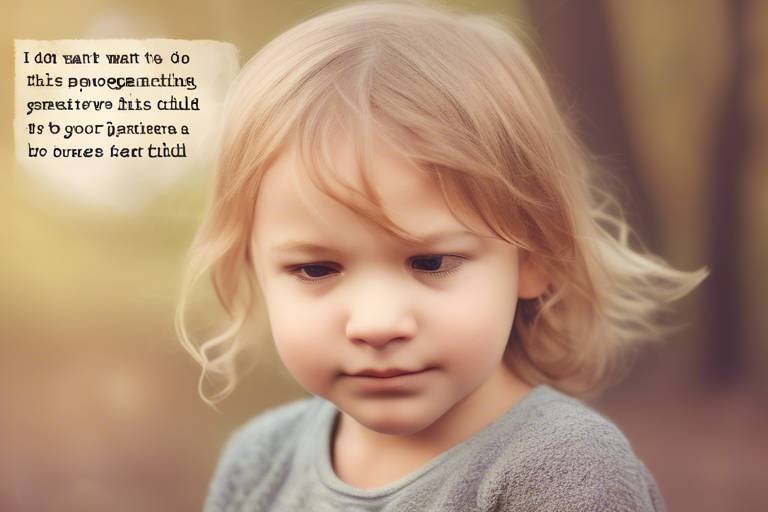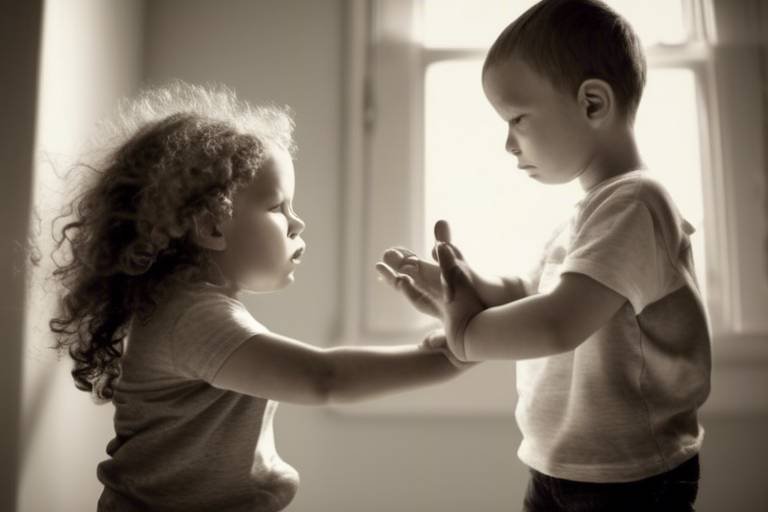Developing Your Child’s Social-Emotional Skills
In today’s fast-paced world, nurturing your child's social-emotional skills is more important than ever. These skills are not just about making friends or fitting in; they lay the foundation for emotional intelligence, resilience, and the ability to forge meaningful relationships throughout life. So, what exactly are social-emotional skills? They encompass a range of abilities that help children recognize their own emotions, understand the feelings of others, manage their emotional responses, and establish positive connections. Think of these skills as the building blocks of a child’s emotional toolkit, equipping them to navigate the complexities of life with confidence and grace.
As parents and educators, it's our responsibility to foster these skills from an early age. Imagine your child walking into a room full of new faces. With strong social-emotional skills, they can read the room, pick up on social cues, and engage with others in a way that feels natural and comfortable. Conversely, a lack of these skills might leave them feeling isolated or misunderstood. The good news is that social-emotional skills can be taught and reinforced through everyday interactions and activities. By being intentional about nurturing these abilities, we can help our children thrive socially and emotionally.
So, how do we go about developing these essential skills? Start by creating an environment that encourages emotional expression. When children feel safe to share their feelings, they learn to identify and articulate their emotions. This open dialogue is crucial; it builds trust and strengthens the parent-child bond. Additionally, incorporating fun and engaging activities like games, storytelling, and role-playing can make learning about emotions enjoyable. It’s all about making the process interactive and relatable. Remember, the goal is to equip your child with the tools they need to understand themselves and others better.
In conclusion, developing your child's social-emotional skills is not just an option; it's a necessity in today's world. By focusing on emotional intelligence, resilience, and the ability to build positive relationships, we can empower our children to face life's challenges head-on. The journey may require patience and creativity, but the rewards—stronger relationships, better communication, and enhanced emotional well-being—are truly invaluable.
- What are social-emotional skills? Social-emotional skills are the abilities that help individuals recognize and manage their emotions, establish positive relationships, and make responsible decisions.
- Why is emotional intelligence important? Emotional intelligence is crucial because it influences how children empathize with others, communicate effectively, and navigate social situations, impacting their overall success in life.
- How can I help my child recognize emotions? You can help by engaging in activities like games, storytelling, and role-playing that focus on identifying and discussing emotions.
- What role does resilience play in social-emotional development? Resilience helps children cope with setbacks and challenges, fostering a positive outlook and emotional stability.
- How can I encourage positive relationships in my child? Encourage your child to engage in teamwork, practice conflict resolution, and communicate openly with peers to foster positive relationships.

Understanding Social-Emotional Skills
Social-emotional skills are more than just buzzwords; they are the foundation upon which children build their futures. These skills encompass a range of abilities that allow children to recognize their own emotions, understand the feelings of others, manage their reactions, and establish positive relationships. Think of social-emotional skills as the emotional toolkit that children carry with them throughout life. Just as a carpenter needs tools to build a sturdy house, children need these skills to navigate the complexities of social interactions.
At the core of social-emotional skills is the ability to recognize emotions. This means not only identifying what they are feeling but also understanding why they feel that way. For instance, when a child feels angry, they may need to understand that this emotion could stem from feeling left out or misunderstood. By recognizing these emotions, children can learn to communicate their feelings more effectively, leading to healthier relationships with peers and adults.
Another critical component is the ability to manage feelings. This involves regulating emotions in different situations, which is essential for emotional well-being. Imagine a child who feels overwhelmed during a group project; if they can manage their anxiety and express their concerns calmly, they are more likely to contribute positively to the team. It’s like learning to ride a bike: at first, it may seem daunting, but with practice, it becomes second nature.
Establishing positive relationships is the final piece of the puzzle. Children who possess strong social-emotional skills are more adept at forming connections with others. They learn to share, cooperate, and empathize, which are all vital for fostering friendships and maintaining healthy interactions. In essence, these skills not only enhance individual well-being but also contribute to a harmonious community.
To further clarify, here’s a quick breakdown of the key components of social-emotional skills:
| Component | Description |
|---|---|
| Emotion Recognition | The ability to identify and understand one's own emotions and those of others. |
| Emotion Management | The capacity to regulate emotions in various situations, leading to better responses. |
| Relationship Building | The skills needed to create and maintain positive relationships with peers and adults. |
In conclusion, understanding social-emotional skills is crucial for parents and educators alike. By nurturing these skills, we equip children with the necessary tools to thrive emotionally and socially. This investment in their development not only benefits them but also enriches the communities they are part of, creating a ripple effect of positive interactions and relationships.
- What are social-emotional skills? Social-emotional skills are abilities that help children recognize and manage emotions, establish positive relationships, and navigate social situations effectively.
- Why are these skills important? They are critical for emotional well-being, academic success, and overall life satisfaction, as they help children interact positively with others.
- How can parents help develop these skills? Parents can foster these skills by encouraging open communication, modeling emotional regulation, and providing opportunities for social interaction.

The Importance of Emotional Intelligence
Emotional intelligence is more than just a buzzword; it’s a vital skill that shapes a child's journey through life. Think of it as the compass that guides them through the often turbulent waters of social interactions and personal challenges. When kids develop emotional intelligence, they not only understand their own feelings but also grasp the emotions of those around them. This understanding fosters empathy, which is crucial for building strong, healthy relationships.
Imagine a world where children can navigate conflicts with grace, communicate their needs effectively, and support their friends during tough times. That’s the power of emotional intelligence! It’s like having a superpower that helps them connect with others on a deeper level. Studies show that children with high emotional intelligence tend to perform better academically, have stronger friendships, and are more resilient when facing life's challenges.
But what exactly does emotional intelligence encompass? It involves a few key components:
- Self-awareness: Understanding one's own emotions and how they affect thoughts and behavior.
- Self-regulation: The ability to manage emotions and impulses effectively.
- Social awareness: Recognizing and understanding the emotions of others.
- Relationship management: The ability to develop and maintain healthy relationships.
By cultivating these skills, children can navigate social landscapes with confidence. They learn to express their feelings in a constructive manner, reducing the likelihood of emotional outbursts or misunderstandings. This skillset not only enhances their interactions but also boosts their overall mental health.
Moreover, emotional intelligence is linked to academic success. When children can manage their emotions, they are better equipped to focus on learning and can handle stress more effectively. This leads to improved concentration and better grades. It’s like having a mental toolkit that prepares them for the challenges of school and beyond.
In conclusion, nurturing emotional intelligence in children is not just about helping them get along with others; it’s about equipping them with the tools they need to thrive in life. Parents and educators play a crucial role in this development, providing guidance and support as children learn to navigate their emotional worlds. By fostering these skills, we prepare our children not just for success in school, but for success in life.
- What is emotional intelligence? Emotional intelligence refers to the ability to recognize, understand, and manage our own emotions while also being able to recognize and influence the emotions of others.
- How can I help my child develop emotional intelligence? Encourage open discussions about feelings, model emotional awareness, and provide opportunities for your child to practice empathy through social interactions.
- Why is emotional intelligence important? It helps children build stronger relationships, communicate effectively, and manage stress, leading to better academic performance and overall well-being.

Recognizing Emotions
Teaching children to recognize their own emotions and those of others is a vital stepping stone in their social-emotional development. Imagine emotions as a colorful palette; each hue represents a different feeling. Just as an artist needs to understand colors to create a masterpiece, children must grasp their emotions to navigate life effectively. When children can identify what they're feeling—whether it's joy, sadness, anger, or excitement—they become more adept at expressing themselves and responding to others. This skill not only enhances their empathy but also fosters better interactions with peers.
To help children recognize emotions, parents and educators can introduce various engaging activities that make learning about feelings both fun and impactful. For instance, consider using storytelling as a tool. When reading a book, pause and ask questions like, "How do you think the character feels right now?" This encourages children to think critically about emotional cues and relate them to their experiences. Another effective method is through role-playing. By acting out different scenarios, children can practice identifying emotions in a safe space, helping them learn how to respond appropriately in real-life situations.
Additionally, incorporating games that focus on emotions can be a delightful way to reinforce these concepts. For example, you could play a game where children draw facial expressions or act out different feelings. This not only makes the learning process enjoyable but also solidifies their understanding of emotional recognition. Here’s a quick overview of some engaging activities:
| Activity | Description |
|---|---|
| Storytelling | Discuss characters' emotions during reading sessions. |
| Role-Playing | Act out various scenarios to practice emotional responses. |
| Emotion Charades | Children act out different emotions while others guess. |
Creating an environment where children feel comfortable discussing their emotions is equally important. Encourage them to express how they feel without judgment. This practice not only builds their emotional vocabulary but also strengthens the parent-child bond. When children know they can share their feelings openly, they are more likely to seek help and support during challenging times. Remember, the goal is to empower children to articulate their emotions, which in turn fosters a deeper understanding of themselves and the world around them.

Strategies for Teaching Emotion Recognition
Teaching children to recognize emotions is like giving them a new set of glasses through which they can see the world more clearly. It’s not just about knowing when someone is happy or sad; it’s about understanding the nuances of feelings that can change in a heartbeat. Here are some effective strategies that can help parents and educators nurture this essential skill in children.
One engaging way to teach emotion recognition is through games. For instance, you can play a game where you make different facial expressions, and the child has to guess the emotion you are portraying. This not only makes learning fun but also helps children connect physical expressions with feelings. You can also use picture cards that depict various emotions, allowing children to match the facial expressions with the corresponding emotion. This visual and interactive approach aids retention and understanding.
Another fantastic method is storytelling. Stories can be powerful tools for teaching emotions. When you read a book or tell a story, pause to discuss how the characters might be feeling in different situations. Ask questions like, “How do you think the character felt when they lost their toy?” or “What would you do if you were in their shoes?” This encourages children to think critically about emotions and enhances their empathy towards others.
Furthermore, role-playing can be an incredibly effective strategy. Set up scenarios where children can act out different situations that involve emotional responses. For example, you might create a scene where a friend is feeling left out, and the child has to figure out how to respond. This not only teaches them to recognize emotions but also equips them with the tools to respond appropriately in real-life situations.
Creating a safe space for children to express their feelings is also crucial. Encourage open discussions about emotions at home. Ask them about their day and how certain events made them feel. This practice not only builds their vocabulary around emotions but also reinforces the idea that it’s okay to talk about feelings. The more they practice identifying and expressing their emotions, the more adept they will become at recognizing them in others.
Incorporating these strategies into everyday activities can significantly enhance a child’s ability to recognize emotions. By making learning about feelings enjoyable and relatable, you’re not just teaching them a skill; you’re helping them build a foundation for better relationships and emotional intelligence throughout their lives.
- What age should I start teaching my child about emotions? It's beneficial to start as early as preschool age, around 3-4 years old, when children begin to express and recognize basic emotions.
- How can I tell if my child is struggling with emotion recognition? Signs may include difficulty in social situations, frequent misunderstandings with peers, or expressing frustration when trying to communicate their feelings.
- Are there specific books you recommend for teaching emotions? Yes! Books like "The Color Monster" by Anna Llenas and "The Feelings Book" by Todd Parr are excellent for introducing children to various emotions.

Encouraging Open Communication
Open communication is the cornerstone of a strong relationship between parents and children. When children feel safe to express their feelings, they are more likely to develop emotional intelligence. This means they can articulate their emotions, understand others' feelings, and build meaningful connections with their peers. But how do we create this safe space for our kids? It’s simpler than you might think! Start by being an active listener. When your child speaks, give them your full attention. Put down your phone, make eye contact, and show that you genuinely care about what they are saying. This not only validates their feelings but also encourages them to share more openly.
Another effective strategy is to use open-ended questions. Instead of asking, “Did you have a good day?” which can be answered with a simple “yes” or “no,” try asking, “What was the best part of your day?” This invites a more detailed response and allows your child to express their thoughts and feelings more freely. Here are some examples of open-ended questions you might consider:
- “How did that make you feel?”
- “What do you think about that?”
- “Can you tell me more about what happened?”
Additionally, it’s important to model emotional expression yourself. Children learn by example, so when you share your own feelings—whether they’re happy, sad, or frustrated—you teach them that it’s okay to express emotions. You might say, “I felt really overwhelmed today when I had so much to do,” or “I was really excited when I heard about our weekend plans!” This not only normalizes emotional expression but also gives them a framework for discussing their own feelings.
Moreover, creating a routine for discussions about feelings can be incredibly beneficial. Consider setting aside a few minutes each day, perhaps during dinner or before bedtime, to check in with each other. Ask your child about their day, what made them happy, or if anything upset them. This routine can foster a habit of open communication, making it easier for your child to share their feelings in the future.
Finally, remember that patience is key. Building a foundation of open communication doesn’t happen overnight. It takes time, consistency, and a lot of love. Celebrate small victories along the way, such as when your child opens up about their day or expresses their emotions more clearly. These moments are the building blocks of a trusting relationship, and they will pay off in the long run as your child grows into an emotionally intelligent individual.
Q: How can I encourage my child to talk about their feelings?
A: Start by creating a safe environment for discussions about emotions. Use open-ended questions, actively listen, and share your own feelings to model emotional expression.
Q: What if my child is reluctant to share their feelings?
A: Be patient and give them time. Sometimes, children need a little nudge. Establishing a routine for discussing feelings can also help them feel more comfortable opening up.
Q: How can I teach my child to recognize emotions in others?
A: Engage in activities like reading stories or watching movies together. Discuss the characters' feelings and ask your child how they think those characters feel in different situations.
Q: Are there specific games that can help my child with emotional expression?
A: Yes! Games like “Feelings Charades” or using emotion cards can be fun ways to teach children about different emotions and how to express them.

Building Resilience
Resilience is often described as the ability to bounce back from setbacks, and it's a skill that can significantly shape a child's emotional landscape. Imagine resilience as a rubber band; it stretches under pressure but returns to its original shape, often even stronger than before. Teaching children how to develop this vital skill equips them with coping strategies that can help them navigate life's challenges, fostering a positive outlook and emotional stability.
To cultivate resilience in children, it's essential to create an environment where they feel safe to explore their feelings and confront challenges. Here are some effective strategies that can be integrated into daily life:
- Model Resilient Behavior: Children learn by observing their parents and caregivers. When they see adults facing challenges with a positive attitude and problem-solving mindset, they are more likely to adopt similar behaviors.
- Encourage Problem-Solving: Instead of providing immediate solutions to every problem, encourage your child to think critically about potential solutions. Ask guiding questions like, “What do you think we can do about this?” This approach fosters independence and confidence.
- Celebrate Effort, Not Just Success: It's vital to recognize and celebrate the effort your child puts into tasks, regardless of the outcome. This reinforces the idea that trying hard is just as important as achieving a specific goal.
Additionally, fostering a sense of community can significantly enhance resilience. Children thrive when they know they have support from family, friends, and mentors. Encouraging them to engage in group activities, whether it's sports, clubs, or community service, helps them build relationships that provide emotional backing during tough times.
Moreover, teaching children about the importance of self-care can greatly aid in developing resilience. Simple practices such as regular physical activity, healthy eating, and sufficient sleep can improve their overall emotional well-being. When children feel good physically, they are better equipped to handle stress and recover from setbacks.
In summary, building resilience in children is not just about teaching them to endure hardships; it's about equipping them with the tools to thrive in the face of adversity. By fostering a supportive environment, encouraging problem-solving, and promoting self-care, you can help your child develop a resilient mindset that will serve them well throughout their lives.
Q: What is resilience, and why is it important for children?
A: Resilience is the ability to recover from difficulties. It's crucial for children as it helps them cope with stress, overcome challenges, and develop a positive outlook on life.
Q: How can I help my child become more resilient?
A: You can help your child by modeling resilient behavior, encouraging problem-solving, celebrating their efforts, and providing a supportive environment.
Q: Are there specific activities that can help build resilience?
A: Yes! Activities like team sports, group projects, and community service can foster teamwork and support, which are essential for resilience.

Fostering Positive Relationships
Fostering positive relationships in children is not just about teaching them to make friends; it’s about instilling a sense of belonging and community that can last a lifetime. Children who develop strong social connections often experience better emotional health, improved academic performance, and greater overall happiness. But how can we, as parents and educators, help cultivate these vital relationships? It involves a mix of guidance, example, and opportunities for connection.
First and foremost, modeling healthy relationships is crucial. Children learn by observing the adults in their lives. If they see their parents or caregivers engaging in respectful, loving, and supportive relationships, they are more likely to emulate that behavior. This means showing kindness, practicing active listening, and resolving conflicts peacefully. When children witness these interactions, they begin to understand the importance of empathy and respect in their own relationships.
Another effective strategy is to encourage children to participate in team activities and social events. Whether it’s joining a sports team, participating in a school club, or attending community events, these activities provide children with a platform to meet new friends and practice their social skills. Through teamwork, they learn to appreciate different perspectives and develop a sense of camaraderie. For instance, playing a team sport teaches them not just about winning or losing, but about supporting one another and celebrating collective achievements.
Moreover, teaching children about boundaries and consent is essential for fostering healthy relationships. Children should understand that it’s okay to say no and that their feelings are valid. This knowledge empowers them to seek out and maintain relationships that are positive and fulfilling. You can initiate conversations about boundaries by discussing personal space and the importance of respecting others' feelings. For example, you might say, “It’s great to give your friends a hug, but it’s also important to ask if they want one first.”
To further enhance their relationship-building skills, parents can introduce conflict resolution techniques. It’s inevitable that disagreements will arise, but how children handle these conflicts can shape their future interactions. Teaching them to express their feelings, listen to others, and negotiate solutions can help them navigate social challenges effectively. You might role-play different scenarios at home, allowing them to practice these skills in a safe environment. This not only boosts their confidence but also prepares them for real-life situations.
Finally, creating a supportive home environment where children feel safe to express themselves is paramount. Encourage open discussions about their friendships and feelings. Ask them about their day, their friends, and any conflicts they might have encountered. This not only helps you stay connected but also reassures them that they can come to you with any issues they face. By being a trusted confidant, you help them build the confidence to forge and maintain positive relationships.
In summary, fostering positive relationships in children is a multifaceted endeavor that involves modeling healthy behaviors, encouraging teamwork, teaching boundaries, and providing a supportive environment. By investing time and effort into these areas, you’re not just helping your child make friends; you’re equipping them with the skills they need to navigate the complexities of social interactions throughout their lives.
- What are social-emotional skills? Social-emotional skills refer to the abilities that help children understand and manage their emotions, set goals, show empathy for others, establish positive relationships, and make responsible decisions.
- How can I help my child build resilience? Encourage them to face challenges, provide support during difficult times, and teach them problem-solving skills. Celebrating small victories also boosts their confidence.
- Why are positive relationships important for children? Positive relationships contribute to emotional well-being, improve social skills, and provide a support system that helps children navigate life’s challenges.

Teaching Conflict Resolution Skills
Teaching children conflict resolution skills is like giving them a toolbox filled with essential tools they will need throughout their lives. Conflicts are a natural part of human interaction, and learning how to navigate disagreements constructively can set the stage for healthier relationships and a more harmonious environment. Imagine a world where children can express their feelings without resorting to shouting or sulking; this is the power of effective conflict resolution.
One of the first steps in teaching these skills is to help children understand that conflict is not inherently bad. In fact, it can be an opportunity for growth and understanding. When children learn to view conflicts as chances to solve problems together, they develop a collaborative mindset rather than a combative one. This shift in perspective is crucial for fostering positive interactions with peers and adults alike.
To effectively teach conflict resolution, you can introduce several key strategies. Here are a few approaches that can be particularly effective:
- Modeling Behavior: Children learn a lot by observing adults. When they see you handle conflicts calmly and respectfully, they are more likely to emulate that behavior.
- Role-Playing: Create scenarios where conflicts might arise and engage in role-playing exercises with your child. This hands-on practice allows them to explore different outcomes and develop their responses.
- Encouraging Empathy: Teach children to consider the feelings and perspectives of others involved in the conflict. This can help them to respond with understanding rather than frustration.
Additionally, you can introduce a simple framework for resolving conflicts. This framework can act as a guide for children when they encounter disagreements:
| Step | Description |
|---|---|
| 1. Identify the Problem | Encourage children to articulate what the conflict is about. This helps to clarify the issue at hand. |
| 2. Express Feelings | Teach children to express how they feel about the situation without blaming others. |
| 3. Listen to Each Other | Encourage active listening, where each party has a chance to share their perspective without interruption. |
| 4. Brainstorm Solutions | Guide children to come up with potential solutions together, promoting teamwork in solving the issue. |
| 5. Agree on a Solution | Help them agree on a solution that is acceptable to everyone involved, reinforcing the idea of compromise. |
By equipping children with these tools and strategies, we empower them to handle conflicts with confidence and grace. Just like learning to ride a bike, mastering conflict resolution takes practice and patience. So, the next time a disagreement arises, remember that it’s not just about resolving the issue at hand; it’s about teaching valuable life skills that will serve them well into adulthood.
Q1: At what age should I start teaching my child conflict resolution skills?
A1: It’s beneficial to start as early as preschool age. Children can grasp basic concepts of sharing and taking turns, which lay the foundation for more complex conflict resolution skills.
Q2: How can I encourage my child to practice these skills?
A2: Encourage role-playing scenarios at home, and praise them when they handle conflicts well. Providing a safe space for them to express their feelings is also crucial.
Q3: What if my child struggles with conflict resolution?
A3: Every child learns at their own pace. Be patient and continue to model and teach these skills. Consider seeking additional resources or professional guidance if needed.

Encouraging Teamwork and Collaboration
Teamwork and collaboration are essential skills that children need to thrive in both social and academic settings. When kids learn to work together, they not only achieve common goals but also develop a sense of community and belonging. Think of teamwork as a beautiful orchestra; each child plays their unique instrument, contributing to a harmonious outcome. But how do we, as parents and educators, instill this vital skill in our children?
One effective way to encourage teamwork is through group activities. Whether it’s participating in sports, working on a school project, or even engaging in community service, these experiences provide children with the opportunity to collaborate. They learn to appreciate different roles within a team, understanding that every contribution is valuable, much like how each musician adds to the overall sound of an orchestra. This not only enhances their social skills but also builds their confidence in working with others.
Moreover, fostering a spirit of collaboration can be as simple as creating an environment where children feel safe to express their ideas and opinions. When children are encouraged to share their thoughts in a group setting, they learn to listen actively and respect diverse perspectives. This is crucial because it teaches them that collaboration isn’t just about getting things done; it’s about valuing each person’s input and finding common ground. To illustrate this, consider the following table that outlines key benefits of teamwork:
| Benefit | Description |
|---|---|
| Enhanced Communication | Children learn to articulate their thoughts and listen to others, improving their verbal skills. |
| Problem-Solving Skills | Working in teams allows children to tackle challenges collaboratively, fostering critical thinking. |
| Increased Empathy | Teamwork encourages children to understand and appreciate different perspectives. |
| Building Trust | Collaborative efforts create bonds among children, enhancing their ability to trust one another. |
Another fantastic way to promote teamwork is through games and sports. Activities like soccer, basketball, or even cooperative board games require players to work together towards a common objective. These experiences not only teach children about strategy and collaboration but also about the importance of perseverance and celebrating each other’s successes. After all, in a team, everyone contributes to the win, and every loss is a lesson learned together.
In addition to structured activities, it’s essential to foster a mindset of collaboration at home. Encourage your child to involve siblings or friends in household tasks, such as cooking a meal or organizing a playdate. These simple tasks can turn into fun collaborative efforts, teaching children the importance of working together and sharing responsibilities. It’s like building a small community within your home, where everyone plays a part in creating something wonderful.
Lastly, don’t forget to celebrate teamwork! Recognizing and praising your child’s efforts when they work well with others reinforces the value of collaboration. A simple “I saw how well you worked with your friends today!” can go a long way in boosting their confidence and encouraging them to continue developing these essential social-emotional skills.
- Why is teamwork important for children?
Teamwork teaches children essential life skills such as communication, empathy, and problem-solving, which are crucial for their personal and professional futures. - How can I encourage my child to be a better team player?
Engage them in group activities, encourage open discussions, and celebrate their collaborative efforts to foster a positive attitude towards teamwork. - What are some activities that promote teamwork?
Sports, group projects, cooperative games, and community service are excellent ways to encourage teamwork among children.
Frequently Asked Questions
- What are social-emotional skills?
Social-emotional skills are the abilities that help children recognize their own emotions, manage their feelings, and build positive relationships with others. These skills are essential for their overall development and emotional well-being.
- Why is emotional intelligence important for children?
Emotional intelligence is crucial because it influences how children empathize with others, communicate, and handle social situations. A strong emotional foundation can lead to better relationships and greater success in life.
- How can I teach my child to recognize emotions?
You can teach your child to recognize emotions through fun activities like games, storytelling, and role-playing. These engaging methods make learning about feelings enjoyable and help reinforce their understanding of emotional cues.
- What strategies can I use to encourage open communication about feelings?
Creating a safe and supportive environment is key. Encourage your child to express their feelings by actively listening and validating their emotions. This builds trust and strengthens your relationship.
- How can I help my child build resilience?
To help your child build resilience, teach them coping strategies for handling setbacks. Encourage a positive outlook and remind them that challenges are part of growth and learning.
- What are effective ways to teach conflict resolution skills?
Teaching conflict resolution can involve role-playing scenarios where your child practices effective communication and compromise. This empowers them to navigate disagreements constructively and fosters stronger relationships.
- How can teamwork and collaboration benefit my child's social skills?
Engaging your child in group activities teaches them the importance of teamwork and collaboration. These experiences enhance their social skills, promote empathy, and help them understand diverse perspectives.



















